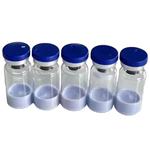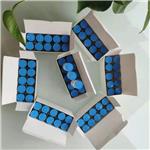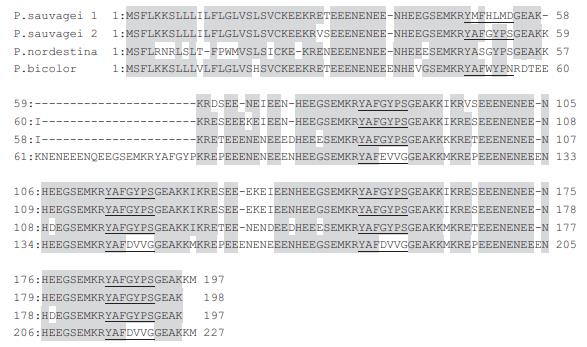DERMORPHIN manufacturers
- Dermorphin
-

- $1.00 / 100mg
-
2025-02-12
- CAS:7614-16-5
- Min. Order: 100mg
- Purity: 98%
- Supply Ability: 500g/month
- Dermorphin
-

- $30.00 / 1Box
-
2024-10-18
- CAS:
- Min. Order: 1Box
- Purity: 99.99%
- Supply Ability: 10000000000
- Dermorphin
-

- $43.00 / 100mg
-
2024-08-15
- CAS:
- Min. Order: 50mg
- Purity: 98%HPLC
- Supply Ability: 50000
|
| Product Name: | DERMORPHIN | | Synonyms: | H-TYR-D-ALA-PHE-GLY-TYR-PRO-SER(AC)-NH2;H-TYR-D-ALA-PHE-GLY-TYR-PRO-SER-NH2;(SER(AC)7)-DERMORPHIN;TYR-D-ALA-PHE-GLY-TYR-PRO-SER-NH2;YAFGYPS-NH2;Dermorphin acetate salt | | CAS: | | | MF: | C40H50N8O10 | | MW: | 802.87 | | EINECS: | | | Product Categories: | Peptide | | Mol File: | Mol File |  |
| | DERMORPHIN Chemical Properties |
| | DERMORPHIN Usage And Synthesis |
| Discovery | Between the 1960s and 1980s, many active peptides
were identified in the skin of the South American leapfrog
belonging to the genus Phyllomedusa. Dermorphin (DM)
was isolated from the skin of P. sauvagei as a potent
opiate-like peptide.1 At present, seven endogenous ana�logs (DM, [Hyp6
]DM, [Lys7
] DM, [Lys7
]DM-OH, [Trp4
,
Ans7
]DM, [Trp4
,Ans7
]DM-OH, and [Trp4
,Ans5
]DM(1-
5)-OH) have been identified. DM is not found in
mammals. | | Structure | DM consists of seven aa residueswith an amidated serine
at the C-terminus. DM does not contain the common N-terminal sequence for the traditional endogenous
opioid peptides (Tyr-Gly-Gly-Phe), and its sequence is
completely different from that of the endomorphins, which
were identified as endogenous μ-opioid peptides that also
do not contain the common sequence. Interestingly, DM
contains D-Alanine (D-isomer amino acid) in its sequence. H-Tyr-D-Ala-Phe-Gly-Tyr-Pro-Ser-NH2. Mr 803. Soluble in water (up to 2mg/mL) and acetonitrile. Dermorphin should be stored at -20°C. It is also
hygroscopic and must be protected from light. | | Gene, mRNA, and precursor | DM and its endogenous analogs are synthesized from
a precursor that contains multiple copies of the progeni�tor sequence. In these cloned cDNAs, the alanine codon GCG occurs at the position where D-alanine is
present in the end product, suggesting a posttranslational conversion of an L-amino acid to its D-isomer carried out by an amino acid isomerase. | | Receptors | DM shows a very high affinity for μ-opioid receptors
and a low affinity for δ-opioid receptors, which are subtypes of opioid receptors belonging to the GPCR
superfamily. | | Clinical implications | DM produces a long-lasting antinociceptive activity,
with more than 200 times the potency of morphine.6- [Lys7]DM also exhibits a long-lasting antinociceptive
potency exceeding that of morphine by 25- to 30-fold
by peripheral administration with high penetration into
the blood-brain barrier. Within synthetic DM analogs,
some of the N-terminal tetrapeptide analogs containing
D-Arg2 have antinociceptive profiles that are distinct from
those of traditional μ-opioid receptor agonists. Preliminary clinical studies found that the analgesic effect of
intrathecal DM (20μg) was profound and lasts significantly longer (43.41±1.64 h) than intrathecal morphine
(500μg, 34.45±2.35 h) or routine pentazocine therapy
(30mg, 10.79±2.23 h). However, DM was never again
introduced in the clinical setting. A few studies have
reported the effects of DM on endocrine systems in
humans. Intravenous infusion (5.5μg/kg per min for
30min) of DM significantly increased the plasma levels
of prolactin, growth hormone, thyrotropin, and renin
activity, but decreased the plasma levels of cortisol. In
fertile women, DM (5.5μg/kg per min for 30min)
decreased the plasma levels of the luteinizing hormone,
but not of the follicle-stimulating hormone. | | Description | A heptapeptide isolated from amphibian skin, dermor�phin, containing D-alanine (a D-isomer amino acid) and
shows very high selectivity for μ-opioid receptors. |
| | DERMORPHIN Preparation Products And Raw materials |
|